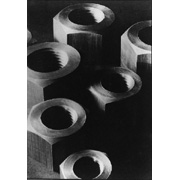| MARGARET BOURKE-WHITE American, 1904-1971 |
||
|
Sigmund Freud published his essay "The Ego and
the Id" in 1923, about the time Renger-Patzsch gazed from the base of a giant
smokestack to its top; the first English edition of the essay was published in
1927, not long after Bourke-White created this study. "The popular theory of the
sexual instinct corresponds closely to the poetic fable of dividing the person
into two halves-man and woman- who strive to be reunited through love," wrote
Freud. Freud said that mental life must be divided into what is conscious and
what is unconscious, a division that photographs frequently mirror. While the
conscious aspect of a photograph can be defined with reasonable precision, the
role of the unconscious can only be speculated upon. Whether Renger-Patzsch intentionally
created a classic icon of the male symbol and Bourke-White a counterpart female
symbol, or whether these pictures are simply involuntary manifestations of the
unconscious, will never be known for certain. |
